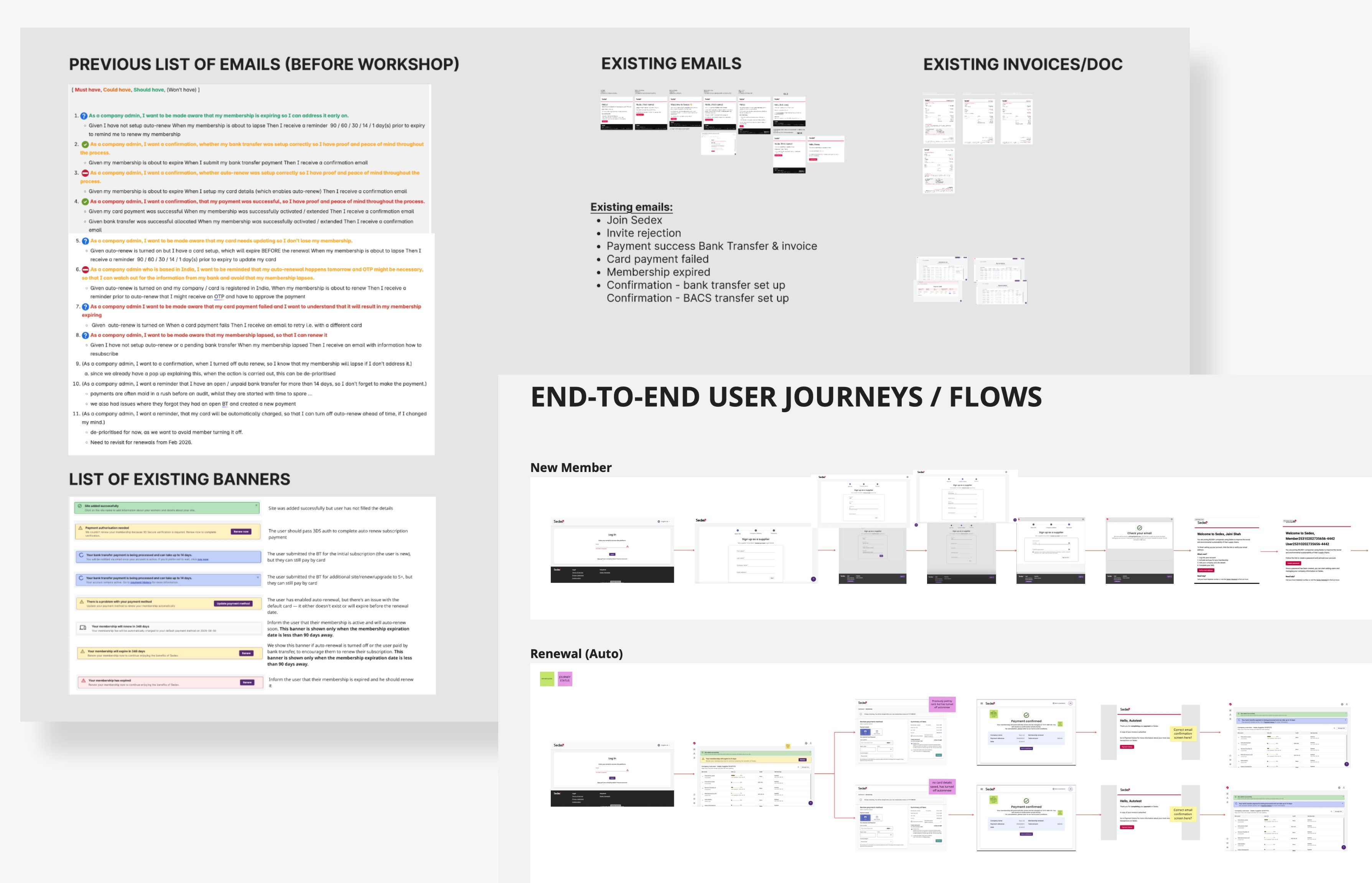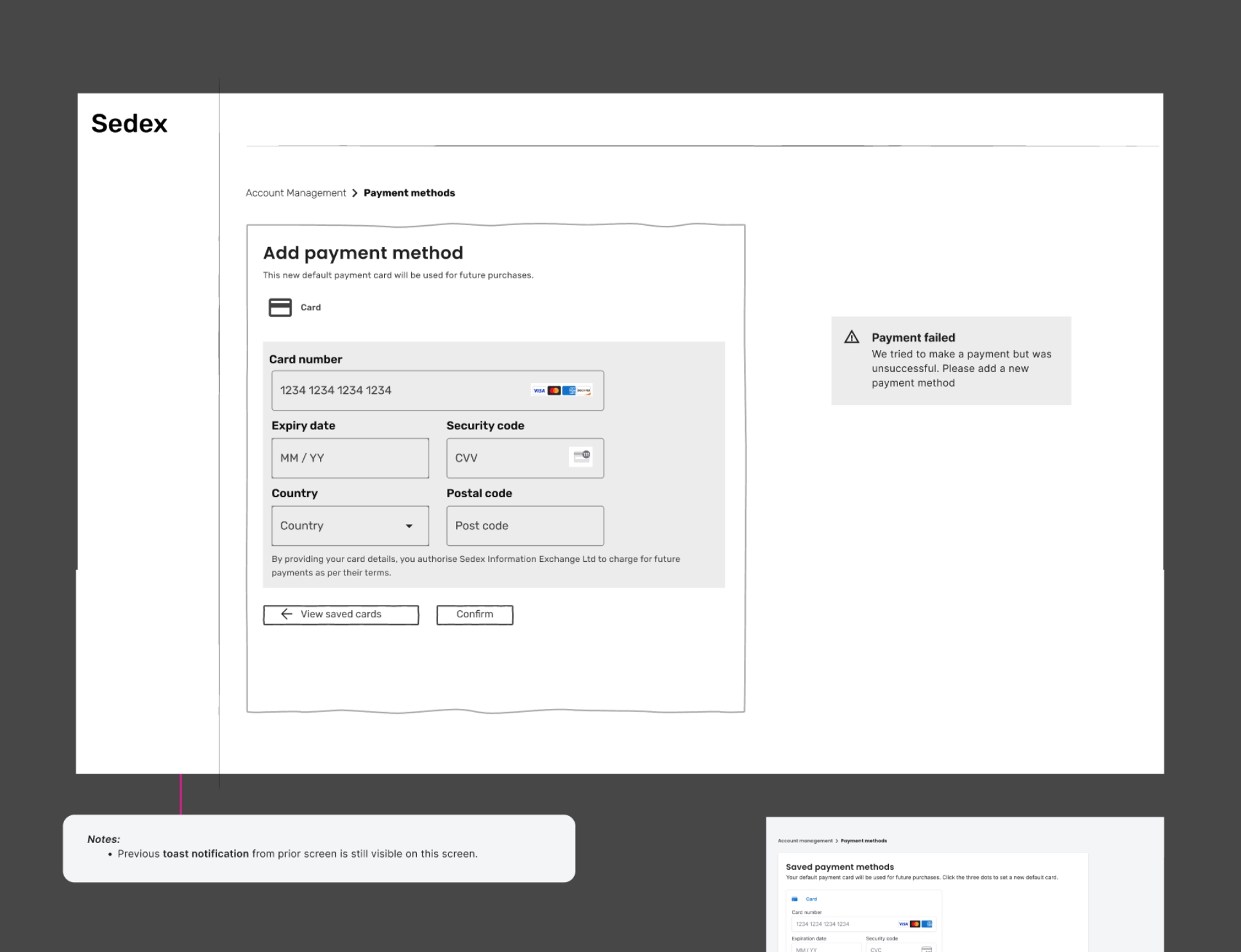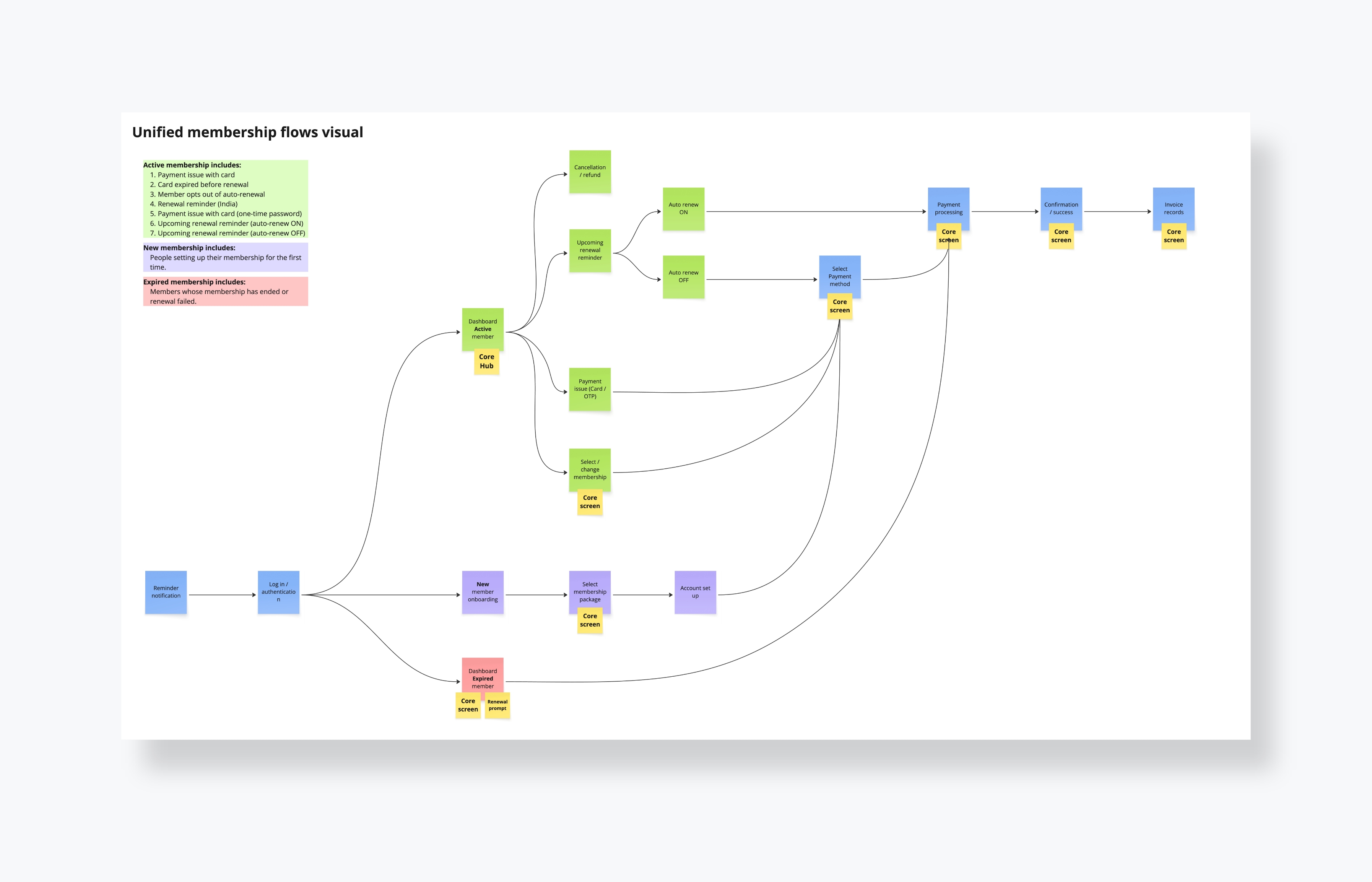Leading a Supplier Payment & Membership Transformation: From Fragmentation to Flow
A global B2B SaaS leader in sustainable supply chains, was undergoing a major digital transformation. Legacy systems were being decommissioned, and Stripe was introduced as the new payment provider. The challenge wasn’t only technical — it was service-led: disconnected processes, misaligned/fragmented artefacts, teams had different versions of truth, and an inconsistent supplier experience were creating friction across every stage of the journey. The project aimed to automate subscription renewals, migrate supplier payment flows, and reduce manual intervention from the Customer Excellence team.
As the Design Lead, I guided the redesign of critical supplier payment flows through a service design lens — orchestrating people, processes, and platforms to create a new frictionless, transparent payment experience that improved clarity for members, reduced operational effort, and laid the groundwork for future scaling.
Context & challenges
Several factors made this project complex:
• No single source of truth / Fragmented ecosystem: Different teams (Product, Engineering, Customer Excellence) had their own artefacts and assumptions, creating misalignment. There was no single, validated view of the supplier journey.
• Technical complexity: Stripe’s auto-renewal behaviour, particularly charging at the lapse date rather than setup date, created member confusion around payment timing and conflicted with the company membership pricing.
• High-volume, low-value transactions: Supplier payments were typically £100–£5,000, but in the hundreds of thousands. Even small frictions created large operational burdens.
• Strategic Business drivers: Revenue from suppliers was critical to the companies' growth. Manual renewal reminders consumed Customer Excellence resources that could be reallocated if automation was implemented effectively — but manual interventions were preventing scale.
During early workshops, we narrowed focus from seven problem areas down to two, with the most urgent being unclear payment status during auto-renew setup, which generated the highest support load.

1. Pulling Together a Fragmented Picture
The first challenge was that there was no single source of truth for the supplier payment journey.
• Figma prototypes didn’t match the live platform.
• Product managers’ Miro flows conflicted with each other.
• Customer Excellence had already flagged at least 10 recurring problem areas, but none had been actioned or designed.
• Meanwhile, the recent move to Stripe introduced new behaviours around auto-renewals and payment timing, which weren’t reflected in any artefacts.
To untangle this, I:
• Collected and audited all existing artefacts across product, design, and support.
• Held meetings with product managers, engineers and Customer Excellence staff — to surface assumptions, contradictions as well as hidden internal workarounds that did not show on the journey
• Consolidated the fragments into a draft customer journey map including both offline (backstage internal interactions) and online comms (frontage (supplier actions) and, which became the first single reference point for discussions.
This wasn’t about creating a polished artefact — it was about making sense of chaos so the organisation could see, often for the first time, how the payment journey actually worked.


2. Facilitating Co-Creation & Cross-Functional Alignment
I planned and ran a two-day ideation workshop bringing together Product, Engineering, Customer Excellence, and Content Design. The sessions focused on generating targeted, high-impact improvements.
The goal was clear: address the biggest points of confusion (auto-renewal setup, card failures, and Stripe payment timing) and create a prioritized, scoped set of ideas ready for handover.
Day 1:
• Framed the problems using cross-functional insights from each discipline.
• Facilitated “How Might We” prompts to turn pain points into creative solution starting points (a first for some members).
• Facilitated individual ideation, capturing the unique perspectives of all participants.
Day 2:
• Continued ideation and grouped ideas for discussion.
• Conducted dot-voting and impact/risk mapping to identify high-value opportunities. Which were:
1. Proactive emails and in-platform communications – coordinated, timely reminders to clarify subscription and renewal status. This also included better transparency – new UI and messaging patterns to explain auto-renewal timing and payment states.
2. Prepay option – allowing members to pay for three months in advance, giving flexibility and clarity.
3. Auto-renew explainer video – a short animation to clearly explain subscription and auto-renewal processes in simple terms.



After the workshop, I coordinated a smaller core project team of five to further explore these ideas.
Together, we:
• Mapped confidence and risk for the selected ideas, helping the group evaluate feasibility alongside impact.
• Developed minimal viable improvements / “smallest slice” versions.
• Prioritized the final ideas and agreed on next steps, creating a clear handover path to the Product Principal for presentation to senior leadership.
Turning points and outcomes:
This alignment was a turning point — went from a scattered set of concerns to a focused shortlist of actionable improvements. Cross-functional discussions surfaced subtle operational nuances — e.g., regional differences in Stripe auto-renewal behaviour — that directly influenced solution concepts.
The workshop built alignment and momentum, giving the organisation a shared understanding of what could be implemented quickly to reduce manual effort and improve supplier clarity.
3. Redesigning Critical Supplier Flows
I led the redesign of the most impactful payment journeys:
• New member onboarding & subscription setup
• Auto-renewal setup and management
• Renewals and reactivation of lapsed members
• OTP password resets (region-specific, e.g., India)
When redesigning auto-renewal, we identified that members weren’t sure if payment had been taken at setup. To address this, I designed flows that confirmed setup clearly at the point of action both through in-platform notifications and via email, while also introducing proactive notifications if payments later failed. This gave suppliers confidence while reducing the need for Customer Excellence to chase failed payments.
Each flow was designed around three guiding service principles:
• Transparency – Suppliers can clearly see payment and subscription status.
• Control – Members can manage payment methods and auto-renew preferences easily.
• Efficiency – Reduce manual intervention for Customer Excellence, leveraging Stripe’s automation capabilities.
The resulting designs served as a blueprint for both experience and operational process, aligning UI, communication, and backend behaviour across regions.
While the flows were ready for alignment, the project was paused before a broader design system evolvement and product roadmap to be established. Nonetheless, the redesigned journeys provided a single, actionable reference for the organisation.







Even though implementation was paused, the work had a measurable organisational effect:
• Alignment achieved: For the first time, Product, Engineering, and Customer Excellence teams shared a unified, validated view of the supplier payment journey.
• Foundation for implementation: Redesigned flows serve as a blueprint ready for implementation once the project resumes.
• Operational efficiency unlocked: Identified Stripe-specific behaviours and clarified processes, helping Customer Excellence anticipate reduced manual workload.
• Supplier clarity: Early mapping and redesign addressed the most confusing points, laying the groundwork for stronger renewal rates.
These outcomes show that design leadership is about enabling the organisation to act strategically, not just producing artefacts.
This project reinforced that leading design in complex environments is about clarity, orchestration, and strategic enablement:
• Alignment drives impact: By facilitating workshops and consolidating fragmented flows, I enabled the organisation to see and solve its own problems more effectively.
• Design leadership is orchestration: My role wasn’t only to design the experience but to align stakeholders, mediate constraints, and turn complexity into a shared vision.
• Systems thinking delivers clarity: By visualising the entire service — not just the interface — design drove impact across product, process, and people.
By focusing on the highest-leverage problems, redesigning critical flows, and preparing the organisation for implementation, I helped this SaaS B2B Company move from fragmentation to readiness, providing a strong foundation for scalable, frictionless supplier payment journeys. In the end, this project was less about designing screens and more about designing alignment — helping teams move from confusion and fragmentation toward a shared vision of frictionless, scalable supplier payments. For me, this project demonstrated that service design is as much about organisational change as it is about user experience.

